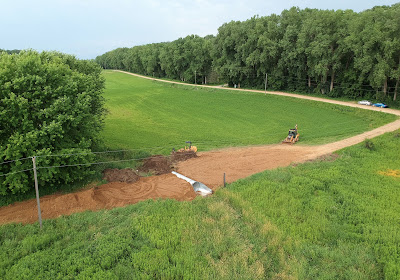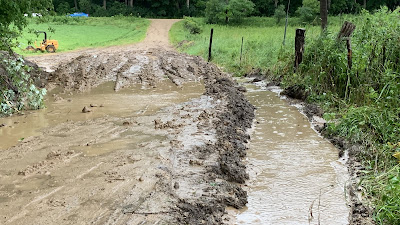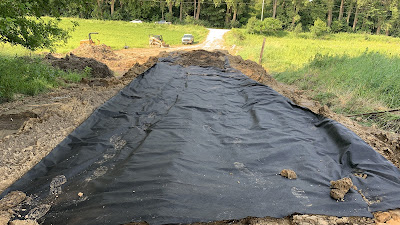ABSTRACT OF TITLE
United States
-to-
Pierre Larivire
No. 3
Land Office Entry
Dated: April 24, 1857
Taken from Abstract of U.S.
Land Office Entries
--------------------------------------------------------------------------------------------------------------------------
Later
---------------------------------------------------------------------------------------------------------------------------
Florence Garrard and Lewis
H. Garrard, her husband
-to-
Fred J. Steffenhagen
No. 51
WARRANTY DEED
Dated: July 14, 1884
Recorded February 28, 1885
Consideration $2500.00
Conveys the following described premises-Beginning at ........
.......thence south 19°30' west 59.43 chains to southwest corner of C.F. Herders land; thence north......
A chain in land measurement is 66 feet, 22 yards, or 20.117 meters. 59.43 chains is 3922.38 feet. That's a long ways through an entire valley, up over the top of a hill and down into bottom land in the next valley. There is simply no way for a surveyor in days of old to draw that straight line and as a result, our family (and our relatives that eventually owned the farm next to us) used the terrain and Kentucky Windage to establish the boundary; fences built reasonably close but not necessarily on the official property line.
In
the first part of the last century, the dry ditch had a more natural
slope. In the 50's when my uncles lived on and ran the farm, a deeper,
narrower ditch was dug to control the valley's water flow, centralizing
the stream and keeping it from spreading it out to the crop land. I can remember dad talking
about getting through the abrupt ditch with his '50 Chevy when dating mom, the extended
bumper almost hanging up during the crossing. Later, a concrete slab
was poured with a hollow culvert beneath, providing a much more gentle transition down and through.
Jump ahead 100 years and the now official property line somehow manages, from our 'dry' ditch that drains roughly 1600 acres upstream up to our access road, to place the very end of our driveway half on our property and half on our neighbors. In practical terms, this placed a section of our concrete slab on our neighbor's land, something he held over us to the point that fighting him and it was more trouble than living with our flooding, so live with it we did. By waiting until 2019, we were under far more stringent Land Use Restrictions in dealing with our local watershed(s).
In 2004, our neighbor and his wife divorced, their property split and farm sold. Our driveway issue came officially to light after the new survey was required and as a result, a legal (expensive) easement was created.
In 2004, our neighbor and his wife divorced, their property split and farm sold. Our driveway issue came officially to light after the new survey was required and as a result, a legal (expensive) easement was created.
If you've been paying attention, the following is all old news. But just in case you weren't around for the excitement.....
2008, January - Drifting extraordinaire .... probably no more than 6" of new snow but it blew and packed.2008, March
2009, March - Spring snow melt...
2012, June - 6 inches of rain over a few hours
2013, March - A late and large snowfall....
2013, March - Rapid melting, deep enough snow that the water is running over the top of the snow in the ditch rather than down inside of it.
2013, April - Still melting, the north slopes of the valley still hanging on to inches of late snow.
2014, January - A nice snowfall...trying to drift and succeeding, the snowfence 'catch' almost at capacity.
2014, March - Thawing, freezing, thawing, freezing....this was about as bad as the flooding got for us to cope with.
2015, September - More heavy rain in a short time span...and more mud erosion.
2016, August - The morning we needed to leave and pick up our U-haul to bring Gramma home from New Mexico.
So you get the idea....lots of workarounds and lots of compromise. Since 2004 we've believed that on balance, not spending the huge costs of driveway improvement would in no way offset the inconvenience. There's room for lots of motel overnights and 'late for the meetings' missed in $50k.
An upstream view of the dry ditch that drains the valley. This dug by my uncles to keep water out of the adjacent crop land. Recent more stringent enforcement (the laws are old, just were never enforced) now requires adjacent buffer zones for erosion control and water quality, meaning no more beans or corn right up to the edge of like ditches. The buffer width increases for actual running water streams.
Top soil pushed aside to access fill from a hill that we could sacrifice.
July 18 it rained and rained some more....
Late July.....
Cars parked on the road.....for over a week. We needed our chore boots, almost wore them out.
Only two days before I needed to get out with the van and trailer for my Wyoming trip, the driveway was passable. I don't need to tell you that alternate vacation plans were being considered because things weren't lookin' good for my departure.
Here are the action shots....
























































Time for a bridge. There’s a lot of water moving through there...
ReplyDeleteRichard, we may need a bridge but the plan is to go in stages....I've got faith we'll be way ahead of where we were.
DeleteNext time I'm in the hood.. I'm go'n to detour and give the driveway the once over....
ReplyDeleteLooking forward to your appraisal.
DeleteFirst thing I thought of when seeing you on and in the culvert: "You damn kids get outa there!!"
ReplyDeleteI remember where that comes from :)
DeleteHere's what I thought of when I climbed in...
Lots of small water retention dams were put in around here back in the late '60's and '70's. We were all standing around talking one day to a neighbor and suddenly he realized his young son was not able to be seen.
"Miles, where are you??"
We heard a very echo-y "In here dad...."
Culvert must have been no more than 18" in diameter, 60-70' long.
In all worked out.
You weren't able to move the driveway over with all that equipment there. Not without cutting down some trees?
ReplyDeleteA big No No, keeping the location we were grandfathered in. Moving meant new meant regulations meant Who Knows What All?
DeleteA nice idea though.
You don't want those guys snooping around.
ReplyDelete